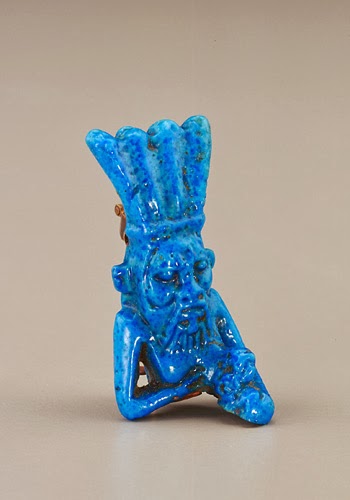Mummypocalypse rolls off the tongue a little better, yes?
Anyways, to move on to more substantive matters, The Smithsonian's Museum of Asian Art has a collection of ancient Egyptian artworks. First thing, how does this qualify as Asian? Second thing, you can actually click on a link and pull up pages and pages of thumbnails of things like busts, jars, plates, figurines, and a bunch of little things which look like amulets for various causes (protection against evil, mostly). And it isn't just thumbnails, either: click on a thumbnail and you get a useful page of information about the object in question. For example:
Amulet of Bes:
"ca. 1075-656 B.C.E or later
Unidentified, Egyptian
Third Intermediate Period or later
Faience (glazed composition)
H: 4.1 W: 2.2 D: 1.9 cm
Egypt
Gift of Charles Lang Freer F1907.386"
"Small amulets made of faience, stone, ceramic, metal, or glass were common personal possessions in ancient Egypt. They were most frequently fashioned in the form of gods and goddesses or of animals sacred to them. Amulets were believed to give their owners magical protection from a wide variety of ills and evil forces, including sickness, infertility, and death in childbirth. They were often provided with loops so they could be strung and worn as a necklace. Some amulets were made to place on the body of the deceased to protect the soul in the hereafter.
Deities and animals represented in the group displayed here are among the subjects most favored for amulets. Taweret, the hippopotamus-headed goddess, and Bes, the dwarf god wearing tall plumes, protected women during childbirth. Cats often symbolized Bastet, a goddess of fertility. Other deities include Sakhmet, the lioness-headed goddess; the ram-headed Khnum, god of creation; and Thoth, god of wisdom, appearing as an ape or vervet monkey. Amulets specifically intended to protect the soul after death often depict Anubis, the jackal-headed god of the underworld, or Duamutef, the jackal-headed son of Horus, who protected the stomach."
For the actual stat page on the Amulet of Bes, see here. For the home page of the art collection, go here. To start in on the thumbnails, go here. Seriously, any of those places is perfect for nerding out.
Next on "For the Love of Night at the Museum": The Mummypocalypse continues to overtake my blog as I discuss the ancient Egyptian art of mummification and why they did it.
Countdown: 309 Days to NATM 3

No comments:
Post a Comment